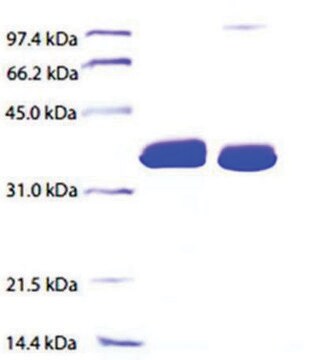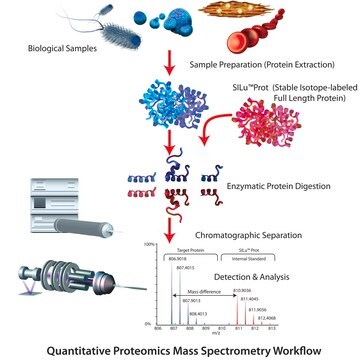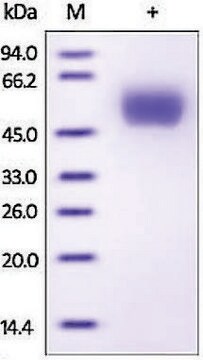SRP4696
ApoE3 human
recombinant, expressed in E. coli, ≥90% (SDS-PAGE), ≥90% (HPLC)
Synonim(y):
Apolipoprotein E3
Zaloguj sięWyświetlanie cen organizacyjnych i kontraktowych
About This Item
Polecane produkty
pochodzenie biologiczne
human
rekombinowane
expressed in E. coli
Próba
≥90% (HPLC)
≥90% (SDS-PAGE)
Postać
lyophilized
masa cząsteczkowa
~34 kDa
opakowanie
pkg of 500 μg
warunki przechowywania
avoid repeated freeze/thaw cycles
metody
activity assay: suitable
zanieczyszczenia
endotoxin, tested
numer dostępu NCBI
numer dostępu UniProt
Warunki transportu
wet ice
temp. przechowywania
−20°C
informacje o genach
human ... APOE(348)
Opis ogólny
Significant quantities of ApoE are produced in liver and brain and to some extent in almost every organ. ApoE is an important constituent of all plasma lipoproteins. It′s interaction with specific ApoE receptor enables uptake of chylomicron remnants by liver cells, which is an essential step during normal lipid metabolism. ApoE exists in three major isoforms; E2, E3, and E4, which differ from one another by a single amino-acid substitution. E3 is the most common isoform and is present in 40-90% of the population. Recombinant human ApoE3 is a 34.0 kDa protein containing 299 amino acid residues. The recombinant ApoE3 was manufactured using animal origin free technology.
Zastosowanie
Human ApoE has been used to study the role of apoE in the activity of LNP (lipid nanoparticles) in order to determine if ApoE has a role to play in the delivery of siRNA to hepatocytes.
Działania biochem./fizjol.
ApoE belongs to a group of proteins that bind reversibly with lipoprotein and play an important role in lipid metabolism. In addition to facilitating solublization of lipids, these proteins help to maintain the structural integrity of lipoproteins, serve as ligands for lipoprotein receptors, and regulate the activity of enzymes involved in lipid metabolism. Apart from participating in the metabolism of plasma lipoproteins, apo-E also interacts with several proteoglycans, such as heparin. The interaction of lipoproteins with proteoglycans in the walls of arteries has been associated with cholesterol deposition linked to atherosclerosis. It is found to be a constituent of several lipoproteins and serves as a ligand for the LDL (low density lipoprotein) receptor, thereby regulating cholesterol and triglyceride homeostasis.
Postać fizyczna
Sterile filtered and lyophilized from 20 mM sodium phosphate.
Rekonstytucja
Centrifuge the vial prior to opening. Avoid freeze-thaw cycles.
Reconstitute in 5 mM Sodium Phosphate pH 7.8 + 0.5 mM DTT to a concentration of 0.1-1.0 mg/mL. The solution can then be diluted into other aqueous buffers and stored at 4°C for 1 week or –20°C for future use.
This page may contain text that has been machine translated.
Kod klasy składowania
11 - Combustible Solids
Klasa zagrożenia wodnego (WGK)
WGK 3
Temperatura zapłonu (°F)
Not applicable
Temperatura zapłonu (°C)
Not applicable
Certyfikaty analizy (CoA)
Poszukaj Certyfikaty analizy (CoA), wpisując numer partii/serii produktów. Numery serii i partii można znaleźć na etykiecie produktu po słowach „seria” lub „partia”.
Masz już ten produkt?
Dokumenty związane z niedawno zakupionymi produktami zostały zamieszczone w Bibliotece dokumentów.
Yuta Suzuki et al.
International journal of pharmaceutics, 510(1), 350-358 (2016-07-05)
Lipid nanoparticles (LNPs) represent the most advanced platform for the systemic delivery of siRNA. We have previously reported the discovery of novel ionizable lipids with asymmetric lipid tails, enabling potent gene-silencing activity in hepatocytes in vivo; however, the structure and
Human apolipoprotein E. Determination of the heparin binding sites of apolipoprotein E3.
Weisgraber KH
The Journal of Biological Chemistry, 261, 2068-2076 (1986)
Emmanuel U Okoro et al.
Biochemical and biophysical research communications, 477(1), 123-128 (2016-06-15)
We previously reported that apolipoprotein E (apoE) upregulates ATP-binding cassette transporter A1 (ABCA1) transcription through phosphatidylinositol 3-kinase (PI3K). Here we demonstrate that treatment of murine macrophages with human apoE3 enhanced Akt phosphorylation, and upregulated ABCA1 protein and mRNA expression. Inhibition
Federica Sebastiani et al.
ACS nano, 15(4), 6709-6722 (2021-03-24)
Emerging therapeutic treatments based on the production of proteins by delivering mRNA have become increasingly important in recent times. While lipid nanoparticles (LNPs) are approved vehicles for small interfering RNA delivery, there are still challenges to use this formulation for
Aladdin Riad et al.
Molecular neurobiology, 57(9), 3803-3813 (2020-06-24)
Our lab has recently shown that the Sigma-2 Receptor/Transmembrane Protein 97 (TMEM97) and Progesterone Receptor Membrane Component 1 (PGRMC1) form a complex with the Low Density Lipoprotein Receptor (LDLR), and this intact complex is required for efficient uptake of lipoproteins
Nasz zespół naukowców ma doświadczenie we wszystkich obszarach badań, w tym w naukach przyrodniczych, materiałoznawstwie, syntezie chemicznej, chromatografii, analityce i wielu innych dziedzinach.
Skontaktuj się z zespołem ds. pomocy technicznej








